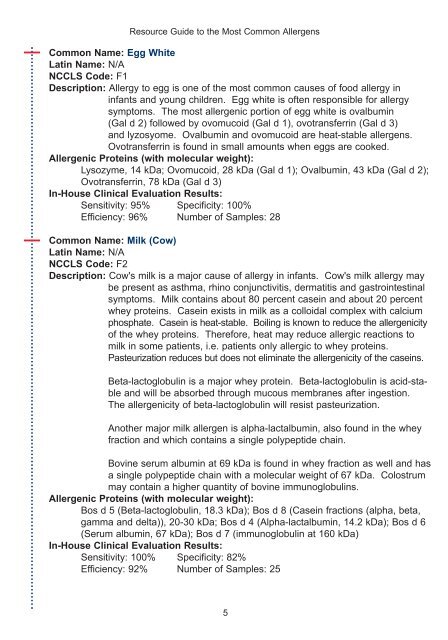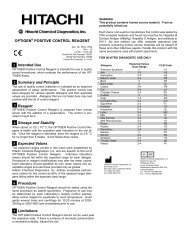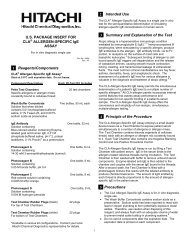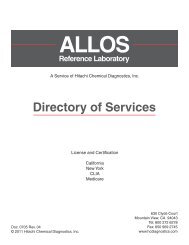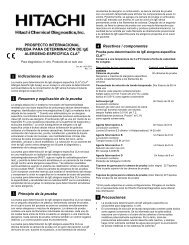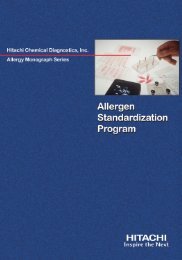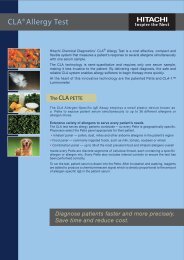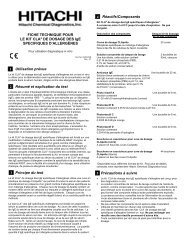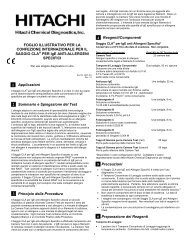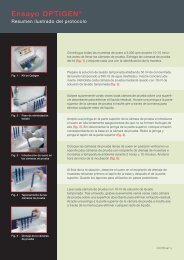Allergen Resource Guide - Hitachi Chemical Diagnostics
Allergen Resource Guide - Hitachi Chemical Diagnostics
Allergen Resource Guide - Hitachi Chemical Diagnostics
Create successful ePaper yourself
Turn your PDF publications into a flip-book with our unique Google optimized e-Paper software.
<strong>Resource</strong> <strong>Guide</strong> to the Most Common <strong>Allergen</strong>s<br />
Common Name: Egg White<br />
Latin Name: N/A<br />
NCCLS Code: F1<br />
Description: Allergy to egg is one of the most common causes of food allergy in<br />
infants and young children. Egg white is often responsible for allergy<br />
symptoms. The most allergenic portion of egg white is ovalbumin<br />
(Gal d 2) followed by ovomucoid (Gal d 1), ovotransferrin (Gal d 3)<br />
and lyzosyome. Ovalbumin and ovomucoid are heat-stable allergens.<br />
Ovotransferrin is found in small amounts when eggs are cooked.<br />
<strong>Allergen</strong>ic Proteins (with molecular weight):<br />
Lysozyme, 14 kDa; Ovomucoid, 28 kDa (Gal d 1); Ovalbumin, 43 kDa (Gal d 2);<br />
Ovotransferrin, 78 kDa (Gal d 3)<br />
In-House Clinical Evaluation Results:<br />
Sensitivity: 95% Specificity: 100%<br />
Efficiency: 96% Number of Samples: 28<br />
Common Name: Milk (Cow)<br />
Latin Name: N/A<br />
NCCLS Code: F2<br />
Description: Cow's milk is a major cause of allergy in infants. Cow's milk allergy may<br />
be present as asthma, rhino conjunctivitis, dermatitis and gastrointestinal<br />
symptoms. Milk contains about 80 percent casein and about 20 percent<br />
whey proteins. Casein exists in milk as a colloidal complex with calcium<br />
phosphate. Casein is heat-stable. Boiling is known to reduce the allergenicity<br />
of the whey proteins. Therefore, heat may reduce allergic reactions to<br />
milk in some patients, i.e. patients only allergic to whey proteins.<br />
Pasteurization reduces but does not eliminate the allergenicity of the caseins.<br />
Beta-lactoglobulin is a major whey protein. Beta-lactoglobulin is acid-stable<br />
and will be absorbed through mucous membranes after ingestion.<br />
The allergenicity of beta-lactoglobulin will resist pasteurization.<br />
Another major milk allergen is alpha-lactalbumin, also found in the whey<br />
fraction and which contains a single polypeptide chain.<br />
Bovine serum albumin at 69 kDa is found in whey fraction as well and has<br />
a single polypeptide chain with a molecular weight of 67 kDa. Colostrum<br />
may contain a higher quantity of bovine immunoglobulins.<br />
<strong>Allergen</strong>ic Proteins (with molecular weight):<br />
Bos d 5 (Beta-lactoglobulin, 18.3 kDa); Bos d 8 (Casein fractions (alpha, beta,<br />
gamma and delta)), 20-30 kDa; Bos d 4 (Alpha-lactalbumin, 14.2 kDa); Bos d 6<br />
(Serum albumin, 67 kDa); Bos d 7 (immunoglobulin at 160 kDa)<br />
In-House Clinical Evaluation Results:<br />
Sensitivity: 100% Specificity: 82%<br />
Efficiency: 92% Number of Samples: 25<br />
5


